The Baby Tarpon Deceiver
The Baby Tarpon Deceiver
By Troy C. Harrington
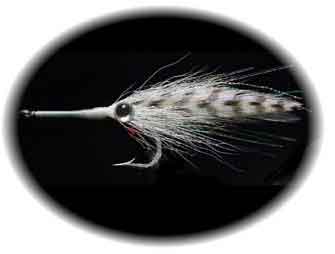 Use large flies for large fish, right? Well, not always. Tarpon are a good example of this. At times they do eat mullet and other fish of that size, but for a good part of the year their diet consists of smaller items such as shrimp, pilchard, and glass minnows. It is this “match the hatch” approach that needs to be taken when considering your fly selection. Especially during the hot summer months when the standard forage base consists of small fish.
Use large flies for large fish, right? Well, not always. Tarpon are a good example of this. At times they do eat mullet and other fish of that size, but for a good part of the year their diet consists of smaller items such as shrimp, pilchard, and glass minnows. It is this “match the hatch” approach that needs to be taken when considering your fly selection. Especially during the hot summer months when the standard forage base consists of small fish.
When you look at a selection of tarpon flies you will see many characteristics in common; they are tied on heavy saltwater hooks that won’t bend from playing a large fish, tails that are tied near the bend of the hook so that they will not twist around and foul, a hackle or collar tied directly in front of the tail to add the appearance of bulk, and a hook shank covered with thread if anything at all. Usually they are smaller than you would think.
The first fly to use a non-fouling saddle hackle tail is Lefty Kreh’s Deceiver. He designed this fly during the last half of the 1950s for saltwater striped bass to overcome problems he had been having with then currently used streamers. It has evolved some since its original conception, such as the addition of Mylar and Flashabou, and has proven itself over and over again in both salt and freshwater. One reason for its success is that it can be tied to match just about any forage fish; large or small, bulky or slender, in about every color combination imaginable.
When I spoke to Capt. Adam Redford, a Miami based guide specializing in inshore light tackle fishing, about flies for an upcoming trip for small tarpon, 10 to 30 pound fish known as “baby tarpon”, he gave his recommendations. He said that the flies should be small, around 2" in length, light in color, and with some reflective material added in. Also, the flies should be tied on strong 1/0 hooks with little or no added weight.
Combining all of the aforementioned attributes, the Baby Tarpon Deceiver was born. It is essentially a Lefty’s Deceiver scaled down to approximate the small baitfish of the area while being tied on a hook strong enough for the application. It is a “match the hatch”, durable, non-fouling sort of fly. And it worked well for that trip.
The Baby Tarpon Deceiver
Hook: Mustad 1/0 34007 3x strong stainless steel saltwater, or equivalent
Thread: white 3/0, such as Danville waxed monochord
Tail: saddle hackle, four white hackles flanked by two grizzly, then shouldered by six strands of Flashabou per side
Topping: four strands of Krystal Flash
Collar: white bucktail
Throat: Red Flashabou
Eyes: 3D hologram stick-on, 3/16" silver
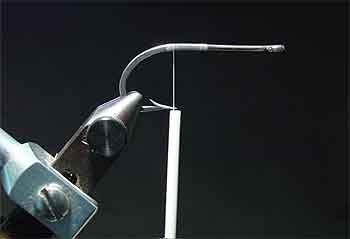
Sharpen the hook. New hooks are not always that sharp and tarpon have very tough mouths. Mount the hook in the vice, at its heel, and start the thread behind the mid point of the hook shank. Wrap a thread base to the rear of the shank and then take a few close wraps forward. This thread base will help to keep the materials from slipping around the hook when tying them in.
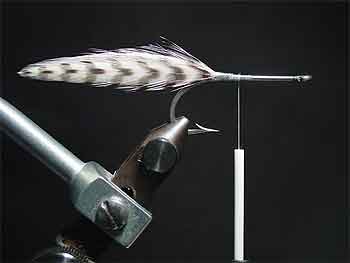
Stack the hackle feathers, curving in, align their tips and stems, and then trim the group (at the butts) to around 2 1/4". Hold the hackle feathers on top of the thread base and secure them to the top of the hook with three “pinch wraps”. At this point check to see that they are in alignment and have not shifted. If things don’t look right, unwrap the thread and try again. If everything seems OK then make firm, contiguous wraps covering the hackle base. Applying glue, such as Zap-A-Gap, to these wraps will help with durability.
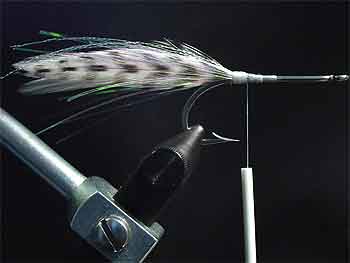
Tie in the Flashabou on both sides of tail. It should extend to about the end of the tail. Next, tie on the Krystal Flash for the topping. It also should extend the distance of the tail.
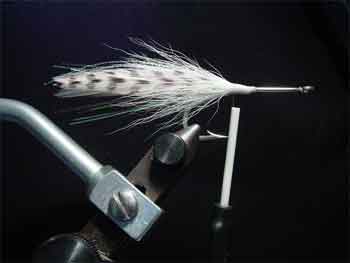
To tie in the collar, select a small clump a bucktail, less than the thickness of a pencil, and clean out the underfur, if any. Don’t worry about stacking it. It should extend to the halfway point of the tail. Hold it against the tail to gauge where it will be tied in at, and then work some head cement (such as Dave’s Flexament) into this point on the bucktail with your bodkin. This will help keep the hair from falling out of the fly when used. Tie in this clump on the far side if the hook shank. Repeat this process on the near side. Trim the butts at an angle and cover tightly with thread. This collar will not only add to the baitfish profile, but will also help to keep the tail from moving and fouling in the bend of the hook.
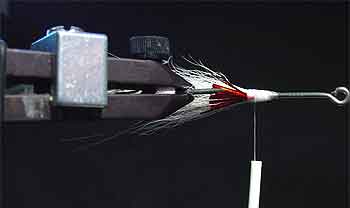
Invert the fly and tie in a clump of red Flashabou for the throat. Trim the Flashabou to be about 3/4 of the hook gap in length. This photo shows the bottom view.
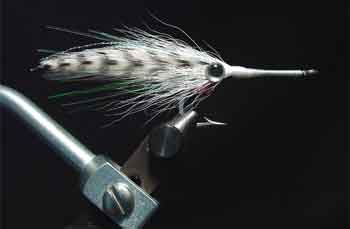
Build a tapered head with the thread and wrap the thread up to the hook eye. Whip finish.
Attach the eyes with Zap-A-Gap to the bucktail along the hook shank behind the thread head. Apply a couple of coats of head cement to all of the thread wraps. Coating the thread with epoxy, instead of the head cement, will add durability to the fly along with weight. Try to work the epoxy back far enough to cover the eyes as well.
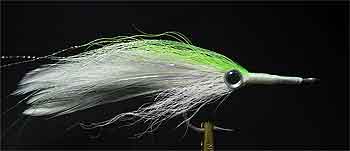
Be sure to try other color combinations. Chartreuse and white is a good choice along with black and white.
For more information on light tackle fishing in the Miami area, check out Adam Redford’s web site at www.captadamredford.com.
|
